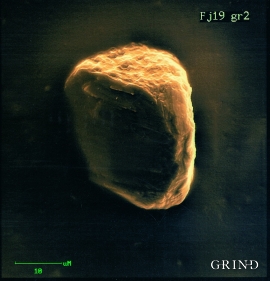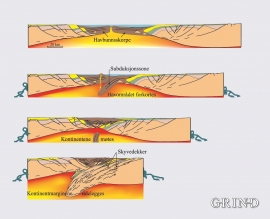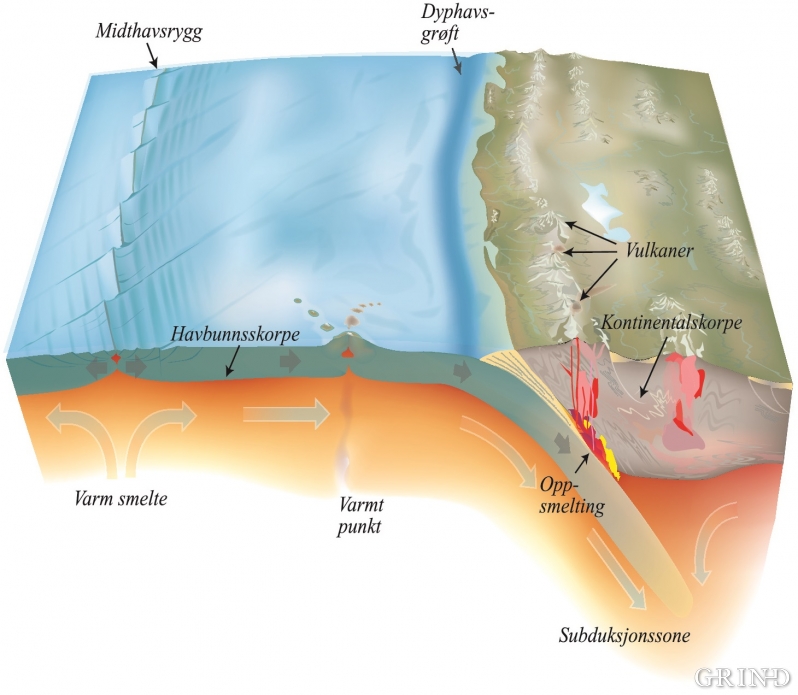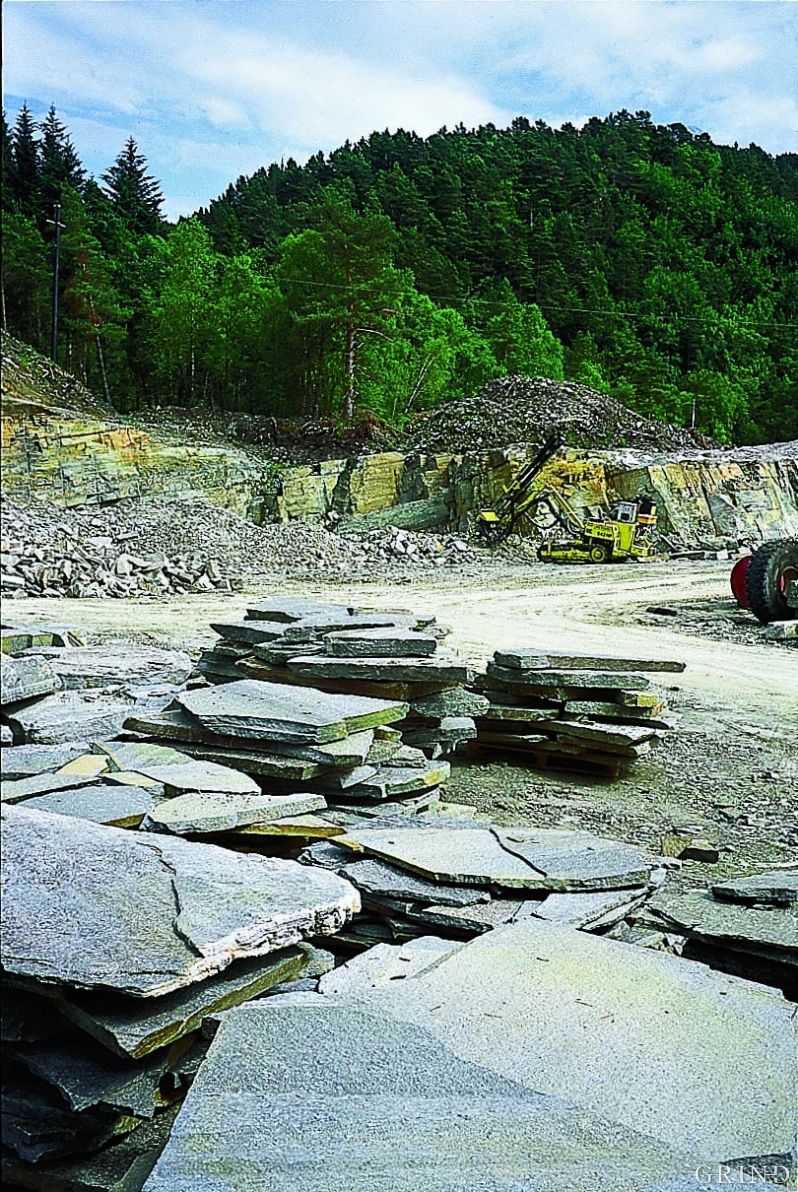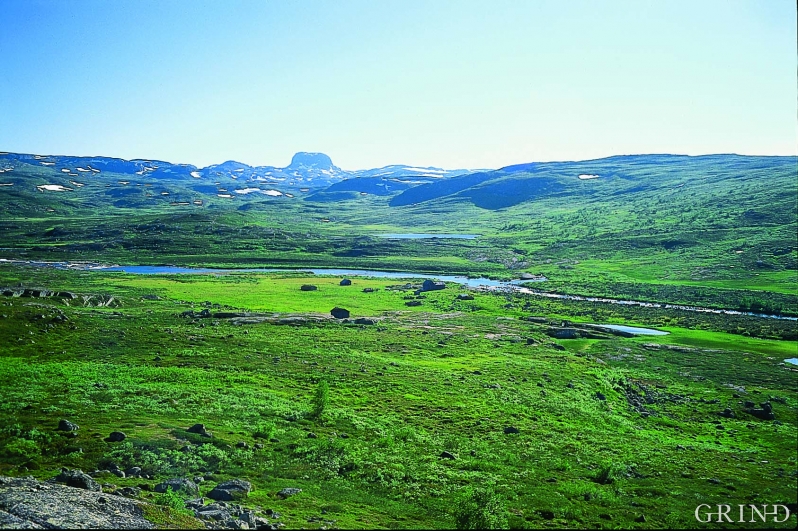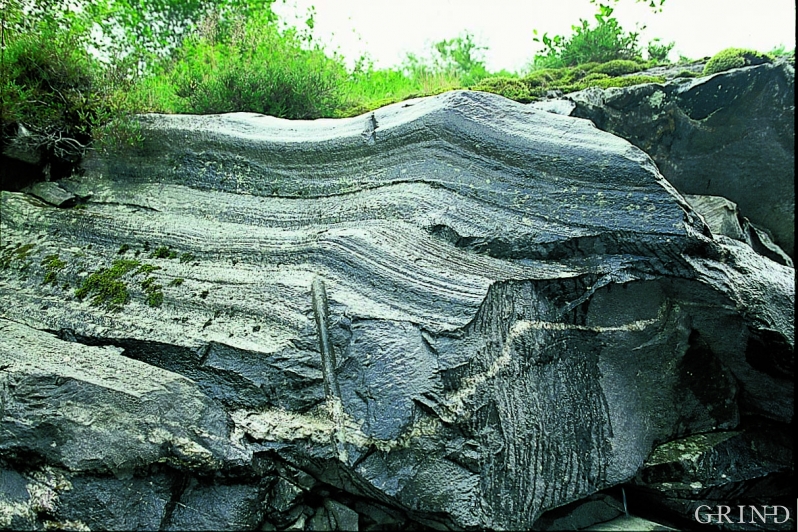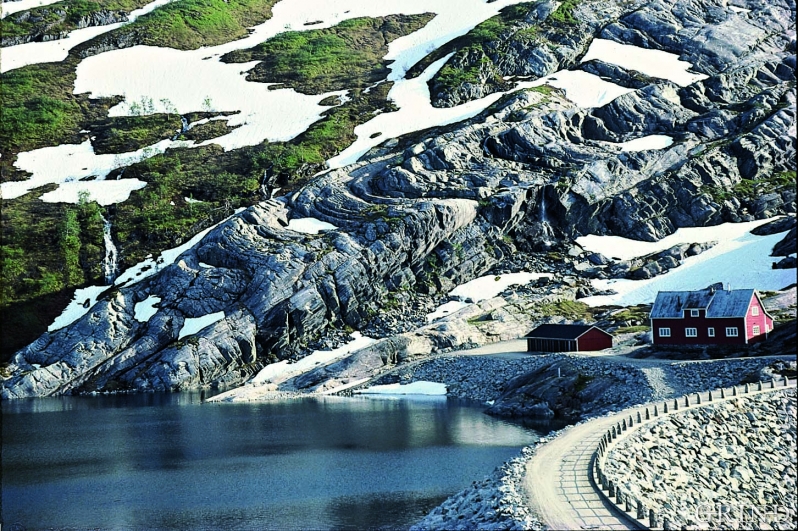Published: 23.05.2019 | Author: Haakon Fossen
Den kaledonske fjellkjeden er borte, men de foldete gneisene som er så vanlige i Hordaland, forteller om kreftene som virket da fjellene en gang ble presset opp. Øst for Bjørsvik, Lindås. (Svein Nord)
The Himalaya Mountain Chain is being formed by the Indian continental plate colliding with the Asian continent. This happens because the earth’s continental plates are constantly moving in relation to each other. Sometimes they crash together and form large collision zones or mountain chains. The collision between India and the Asian continent has created the world's highest mountain and thickest continental crust. But the creation of the Himalaya mountain chain is essentially just a repeat of what happened more than 400 million years ago when Western Norway and Greenland collided and formed the Caledonian mountain range. That mountain-building event caused quite dramatic changes in topography, climate and crustal thickness, and resulted in both volcanism and a lot of earthquake activity. In addition, Hordaland got pressed together to half its size!
Geological catastrophe area
West Norway is part of an old geological catastrophe area, since it lies near the collision zone between two large continents, which crashed into each other 400 million years ago. The damage was quite substantial, especially in the northwest. The continental and oceanic crusts were folded and pressed together. Parts of the crust were essentially squeezed out to the sides as thrust sheets. Modern techniques and a lot of careful work has made it possible to find out about the developments just before and during this collision.
Continents in motion
The Caledonian mountain-building event had a significant effect on Hordaland's bedrock. Intrusive volcanic bedrocks got altered to gneiss, shales to phyllite and mica schist, basalts to greenstones and amphibolites, etc. But what is the reason that continents collide?
We know that large continents essentially "float" upon the heavier mantel, somewhat similarly as a large ice floe floats around on the sea. The oceanic crust is akin to the water and the continental crust the ice floe. Currents in the warm and ductile masses of mantel bedrock under the continental crust cause the continents to move in relation to each other. For example, Norway and Greenland move apart today at a speed of roughly two centimetres per year, while India moves northwards into Asia at a speed of roughly 4-5 centimetres per year. These movements may not sound very impressive, but over the course of millions of years they can amount to several tens of kilometres.
During the latter part of Cambro-Silurian time, ca. 400-500 million years ago, these movements were the opposite of what they are today. This caused West Norway and Greenland to collide in a slow, but nonetheless violent collision. The result was that the earth's crust got pressed together, and an enormous mountain chain (the Caledonian Mountain Chain) rose up along the western edge of Scandinavia and eastern edge of Greenland.
The size of this mountain chain was comparable to the Himalaya Mountains today, where bedrock is being pressed upwards as India slowly but surely crashes into the Asian continent. A collision like this occurs over many millions of years. The strong forces that are at work in such collision zones, or Mountain chains, cause the bedrocks at depth to be pressed flat, or "ironed out". Nearer the surface this causes faulting and strong earthquakes. At that time the mountains towered several kilometres above the current surface of Hordaland, they have gradually been eroded away by rivers, glaciers and other forces that have been working away since Silurian times. We can actually wander around the deep roots of what once was a mountain chain as high as the Himalayas!
Norway at the beginning of the paleozoic
Before the rise of the Caledonian Mountain Chain, all of Norway was a flat continent similar to today's American Midwest or Finland and Russia. Several hundred million years had passed since the previous mountain-building event, and the forces of nature had had good time to wear down the topography. At this time, Norway, the rest of Scandinavia and Russia hung together with Greenland and North America. These continents had been welded together several hundred million years earlier, during the Sveko-Norwegian Mountain-building event.
During the transition from the earth's Precambrian to Palaeozoic Eras this flat landscape sank slowly down into the sea. Thus, a shallow sea was formed, which eventually covered the whole of southern Norway and most of Scandinavia. Layers of beach pebbles, sand and clay gradually accumulated on the sea floor.
Further to the west, between Norway and Greenland, a new sea was being formed. It was created by the gradual pulling apart of Greenland and the rest of the American continent on the one side, from Norway on the other, similarly as is occurring today. Finally, the continental crust between Norway and Greenland collapsed. It was the continental weld from the old Sveko-Norwegian mountain-building event that broke, after having held for over 400 million years. Norway and Greenland parted ways, and a new oceanic crust was formed from the warm magma that flowed up from the mantle to fill the growing space between the continents. The same phenomenon can be seen on Iceland today and along the mid-Atlantic ridge midway between Norway and Greenland.
Norway and Greenland come together again
We do not know how long Norway and Greenland drifted apart from each other. Perhaps they were just as separated as they are today. But at some time during the transition between the Cambrian and Ordovician Periods, roughly 500 million years ago, the direction of movement between Norway and Greenland reversed. The two countries and the continents they belong to began to approach each other again. The oceanic crust that had "just" been formed in the proto-Atlantic ocean between Norway and Greenland began to run out of space, as pressure increased from the two continents that had begun to move toward each other. Oceanic crust is heavier than continental crust and therefore it sank down into the mantle. Thus, one or more subduction zones were formed - zones where oceanic crust is pressed down into the mantle, where it originally came from. This is nature's own wonderful way to recycle bedrock.
Clay sediments and similar deposits that also get pressed down in subduction zones contain relatively large amounts of water. This causes the production of magma at depth. Such magmas are lighter than their surroundings and rise up again through the overlying continental crust. The part of the magma that solidifies on its way up forms deep intrusive rocks, like granite and gabbro. The magma that reaches the surface creates a series of volcanic islands, often in the form of an arc. We find modern examples of such island arcs or island chains at subduction zones in the Pacific ocean.
The so-called exotic Cambro-Silurian bedrocks in West Norway (p. T37) are remnants of such island arcs. We also find remnants of the old oceanic crust that was formed in the proto-Atlantic Ocean area between Norway and Greenland. The deep intrusive bedrocks that got pressed into this oceanic crust are the most abundant of all. In Sunnhordland and Austevoll there are large amounts of these intrusive bedrocks, ranging from early intrusions of gabbro to later grano-diorites and granites. Some extrusive bedrocks (lavas) are also found. It is possible to divide these deep intrusives and lavas from similar, though older bedrocks in the Precambrian basement by using dating methods and chemical analyses. Dating by the uranium-lead and rubidium-strontium methods suggests that the island arcs and subduction zones were already developed by about 490 million years ago and were active from about 430 million years ago.
Many researchers believe that such island arcs were mainly associated with the American/Greenland side of the ancient sea between Norway and Greenland. This must have been a sea with active volcanoes and frequent earthquakes, while Hordaland had quieter conditions. Today, we find remnants of these island complexes both in Newfoundland and along the west coast of Norway as a result of a later collision between Norway and Greenland.
Norway and Greenland collide
Norway and Greenland drifted towards each other for nearly 100 million years in Ordovician-Silurian time. In the end most of the oceanic crust was pressed down into the mantle again. But, the continents continued to move towards one another, and Greenland and Norway eventually crashed in an intense collision. It is not clear exactly when this happened, but it was during the Silurian Period, probably about 425 million years ago.
The two continents were equally buoyant and neither of them were inclined to sink down into the molten hot mantle. In the violent crash that ensued, large parts of the outer edges of the continents got torn off and pushed away from the collision zone. West Norway gave way to the pressure from Greenland, and the West Norwegian crust got pressed down into the mantel during the collision. The farther toward the northwest one travels in West Norway, the deeper the Precambrian basement got pressed down. At the same time, more and more pieces of the basement got torn loose. These were transported to the southeast, over the basement and the overlying clay deposits that had accumulated in the shallow proto-Atlantic ocean in the earliest Palaeozoic. Both the pressure and temperature rose as the crust got pressed further down. This caused the clay deposits over the Precambrian basement to be altered to phyllite and mica schist.
The destruction of the old West Norway is more extensive the farther west or northwest one travels. It is somewhat like two cars colliding. If they crash head on, the degree of destruction will be greatest toward the front. This is what we see today in Hordaland's basement. The southeast was more or less unscathed by the collision, and the structures from the Precambrian remain undisturbed. To the northwest, however, there was much stretching and alteration to gneiss. The Precambrian structures got pressed flat during the collision.
The thrust sheets are coming
Far to the northwest, where today there is ocean, the effect of the collision was greatest. Enormous pieces of the Precambrian basement were torn completely off and pushed southeastwards. The same happened to what was left of the oceanic crust and the volcanic island chain that was formed over the subduction zone. Masses of bedrock that got transported from collision zones like this are called thrust sheets. The thrust sheets got stacked one on top of the other. The stack was thickest to the northwest and thinned out to the southeast. Some of them were transported as far as Oslo. They glided up on the thin layer of phyllite that is found on top of the Precambrian basement surface. The phyllite layer is rich in mica minerals (originally clay minerals) and therefore functioned effectively as a lubricant aiding the transport. In the “cake-model of Hordaland's geology” the phyllite is the soft, thin “vanilla-layer” over the thick cake-base. The overlying cake-layers glided best on the surface of this vanilla-layer.
The continental thrust sheets
The Precambrian basement rocks were transformed into both large and small thrust sheets during the collision. Some of the thrust sheets were torn off far to the north of Hordaland, others further to the southeast. The largest thrust sheet found today is known as the Jotun thrust sheet. It stretches from Vikafjellet in the west to Valdres in the east and was once many kilometres thick. This thrust sheet is best preserved in Jotunheimen. Here, it overlies the phyllite layer over large areas. As we near Hordaland the Jotun thrust sheet is less continuous. We see valleys that cut through both the thrust sheet and the phyllite to the Precambrian basement, while the thrust sheet forms the well known bare-faced mountains Reineskarvet and Hallingskarvet. When we come inland over the Hardangervidda Plateau, most of the thrust sheets are gone. Only the highest tops, such as Hardangerjøkulen and Hårteigen, are thrust sheet bedrocks that have survived being eroded away. As one approaches Røldal and Haukeli, much of the thrust sheet is again preserved. These are collectively referred to as the Hardanger-Ryfylkedekkene thrust sheets. From Vikafjellet to Hardanger, we find the Bergsdalsdekkene thrust sheets as gigantic lenses or plates between the Jotundekket thrust sheet and the Precambrian basement, partly incorporated into the phyllite during the violent movements.
The large basement thrust sheets, like the Jotundekket and Hardanger-Ryfylkedekkene, are interpreted to be West Norway's northwesterly extension prior to the collision between Norway and Greenland. The old Hordaland was broken into sheets that were partially stacked one on top of another. If we pull these thrust sheets back so that they lie one after another, it appears that the large basement sheets must have been located northwest of today's coastline. We are talking about transport of these enormous thrust sheets on the order of several hundreds of kilometres. Both Hordaland and Sogn and Fjordane must have stretched far to the northwest and thus probably extended several times further than their area today. During this transport, which lasted for several millions of years, the phyllite layer under the thrust sheet package was strongly flattened. The original layering that was formed as the clay-rich layers were deposited got largely erased. One can also see folds in the phyllite that were created when the thrust sheets moved over them like a gigantic sledge. But in some places the bedrocks covering the thrust sheets also got destroyed or deformed.
Most of the deformation and alteration occurred along the base of the thrust sheets. Many of the Precambrian structures are therefore preserved in the higher parts of the thrust sheets, and these resemble in part those observed in the Precambrian basement beneath the phyllite. The Jotundekket thrust sheet is the best example of this. Along its base the bedrock is flattened so much as to be unrecognizeable, but a couple of hundred metres above the Precambrian basement structures seem essentially to have been unaffected by the Caledonian deformation.
Caledonian «racing stripes»
The Caledonian deformation of the covering rocks resulted many places in a layering that was formed during the transport event. In addition, a striping effect or linear structure was often developed in these layers. Geologists call such penetrating linear structures lineations . This can be balls of conglomerate that have been drawn out in a particular direction, as in Sandviksfjellet in Bergen (p. R336), or it can be accumulations of minerals that have assumed an oblong, almost pencil-shaped form from the transport of the thrust sheet. Such lineations are of special interest because they can tell us something about the direction the thrust sheets were transported during the collision.
There is a lot of disagreement about what this connection actually is. During the first part of the 19th Century, many agreed with the German geologist Sander, that the lineations must have been formed across the direction of movement, roughly as rollers lie under and transverse to something heavy being drawn over them. Toward the middle of the 19th Century the understanding was that the lineations were formed by stretching when the enormous thrust sheets moved and therefore that they pointed in the direction of transport. The doctorate work of Bergen geologist Anders Kvales in the 1940s was important for this newer interpretation of the Bergdals thrust sheets. He mapped the lineation pattern in the area of Kvamskogen-Voss and interpreted them to show transport of the thrust sheets to the east over the Precambrian basement and phyllite zone. This interpretation holds in large measure today.
The exotic oceanic cover rocks
Exotic bedrocks lie on top of the Precambrian basement thrust sheets. These rock types comprise their own family of thrust sheets that were stacked on top of the Precambrian thrust sheets during the collision between Greenland and Norway. We find them preserved in the coastal areas of Hordaland. They have also at one time existed further to the east but were removed there by land upheaval after the Ice Age and erosion. These are the rock types that have probably been transported farthest from their original site of deposition. As mentioned over, they may have been formed on the Greenland side of the ocean that divided Norway and Greenland before the collision. During the collision they were pressed up onto the Precambrian basement both in West Norway and in East Greenland.
There are also large areas in these exotic, oceanic covering rocks that remain unaffected by the transport over the Precambrian basement. This applies especially to the rigid deep intrusive rocks of the Sunnhorland and Austevoll areas where the structures from their origins and oceanic past are preserved.
The collapse of the mountain chain
After Greenland and Norway had collided and West Norway had been pressed down deeply to the west, the collision process stopped. The strong forces that pressed these two continents together weakened, and the continents began to move apart again. This occurred in the beginning of the Devonian Period, about 405 million years ago. How do we know that the movements changed direction at this time?
We have already mentioned that when the thrust sheets got pressed inwards, most of the deformation occurred along the phyllite zone under and in the base of the thrust sheets.
If one studies the many structures that are preserved in this zone, they show that the thrust sheets were mainly transported toward the west and northwest. This is the opposite of what one would expect. Most were and still are agreed that the thrust sheets moved toward the southeast from the collision between Norway and Greenland. Closer inspection shows, however, that there is an older set of structures that were formed by the inward transport of the thrust sheets. The story is thus clear: After being shoved inward the whole package of bedrock was transported back toward the northwest. One figures that this reversal in the movement of the thrust sheets was on the order of 20-30 kilometres. This is an impressive distance to move such an enormous volume of bedrock, even though it only comprises about a tenth of the entire landward transport distance.
In order to understand what happened during the collision, one can imagine a father who pushes his child on a sleigh (thrust sheets) uphill over the snow on a gentle hill. When the father stops pushing the sleigh slips back a little, just as the thrust sheets slipped back a little toward the northwest.
After the thrust sheets had slid back some tens of kilometres, the movement stopped. The earth's crust in West Norway was now divided up by giant faults. At depth the bedrock was more malleable due to the higher temperature and pressure, so the bedrock here got drawn out like a soft dough. Hardanger Fjord follows along one of these "fault zones" that once lay deep under the earth. The northwest side of the fjord has fallen down several kilometres in relation to the southeast side. This is why we find Precambrian bedrocks all the way at the top of the Folgefonn Peninsula, while we find well preserved exotic rock types on the northwest side. Another significant zone runs along Fens Fjord, which marks the eastern boundary of what geologists call the Bergen Arcs. Also here, the western side has fallen down in relation to the eastern side. Along the old road in Seljestadjuvet in the Odda municipality one can see a lesser version of these zones of movement. These are structures that have had a large influence on the development of land forms, especially Hardanger Fjord, which is in large part carved out along one of these large collapsed structures.
Both the gliding backwards of the thrust sheets and the (north)west trending zones of transport made the earth's crust thinner. It had become extra thick during the collision, and needed to be thinned out to a more normal and stable thickness. When this happened, the earth's crust on West Norway could settle down.
Når jordskorpen slites i to
Jordskorpen utsettes hele tiden for en form for spenning. Når kontinenter beveger seg fra hverandre eller splittes på midten, skyldes det krefter som drar og sliter i skorpen. Når slike krefter blir sterke nok, fører det til at skorpen blir tynnere, omtrent som når vi drar en bit modellervoks i begge ender. De nedre delene av jordskorpen oppfører seg som varm modellervoks, mens den øverste og kaldeste delen bryter opp langs sprekker og forkastninger. Etter en tid vil skorpen bli så tynn at magma lett trenger opp til overflaten og danner ganger og vulkaner. Til sist vil hele skorpen ryke og tomrommet fylles av basaltiske størkningsbergarter – dypbergarter og dagbergarter som sammen danner havbunnsskorpe. En slik utvikling fant sted da Grønland og Norge begynte å drive fra hverandre i slutten av jordens urtid, forut for den kaledonske fjellkjededannelsen. Strekkreftene virket så lenge og så sterkt at et forhistorisk «atlanterhav» ble dannet mellom Grønland og Norge.
Vestlandet i dypet
Bergarter som utsettes for økende trykk og temperatur, gjennomgår en omdanning, spesielt dersom bergarten inneholder bevegelige væsker. Mineraler får ny krystallstruktur, eller helt nye mineraler vokser på bekostning av de gamle, ustabile mineralene. Fyllittlagets mineraler forteller om økende temperatur mot nordvest. På Hardangervidda er fyllitten finkornig og uten andre mineraler enn glimmer. Her har ikke fyllitten vært oppvarmet til mye over 300–350 °C. Langs Hardangerfjorden og lenger nordvest blir glimmerflakene større, samtidig som en finner mineralet granat i bergarten. Fyllitten er blitt til en granatglimmerskifer og har vært oppe i temperaturer rundt 400–500 °C. Denne økningen i temperatur (og trykk) mot nordvest viser at de kaledonske skyvedekkene, som beveget seg over fyllitten, ble skjøvet i oppoverbakke mot sørøst. Videre nordvestover økte temperaturen gradvis. Nord for Hordaland, på Sunnmøre, nådde grunnfjellet de største dypene (figur neste side). Geologene snakker her om dyp på over 100 kilometer. Intet annet sted på jorden har bergarter vært dratt ned på større dyp! Trykket var faktisk så stort at ørsmå diamanter ble dannet i gneisene. Diamantene er imidlertid så små at en ikke kan se dem med det blotte øye, og de er derfor ikke helt enkle å finne.
Når kontinentene kommer på kollisjonskurs
Når kontinenter beveger seg mot hverandre, virker kompresjonskrefter eller sammenpressingskrefter i jordskorpen. Først blir havbunnsskorpen mellom kontinentene fraktet ned i dypet langs såkalte subduksjonssoner. Langs vestkysten av Sør-Amerika er det en slik subduksjonssone i dag. Havbunnsskorpe er tyngre enn kontinentalskorpe, derfor dykker havbunnsskorpen ned. Men når selve kontinentene støter sammen, er det ingen av dem som vil ned. Begge flyter nemlig like lett. Kollisjonen kan da bli voldsom, med løsrivning av svære flak (skyvedekker), ødeleggelse og omdanning av tidligere strukturer og mineraler, dramatisk økning i jordskorpens tykkelse, samt imponerende fjellkjeder på jordoverflaten. Det var dette som skjedde da den kaledonske fjellkjeden ble dannet i silurtiden, og de samme prosessene finner nå sted i Himalaya-fjellkjeden.
Skyvedekker
Teorien om skyvedekker, det vil si bergartsflak som blir revet løs og skjøvet til dels lange avstander, er ikke ny. Den ble foreslått for den kaledonske fjellkjeden i Skandinavia i 1888 av den svenske geologen Alfred Elis Törnebohm. Teorien løste et vanskelig problem: at gamle grunnfjellsbergarter fra jordens urtid ligger over den yngre kambrosiluriske fyllitten. Mange hadde imidlertid vanskelig for å tro at svære bergartsmasser skulle kunne flytte på seg på denne måten. Som mange nye teorier løste den noen problemer, men skapte andre.
Hovedproblemet var hvordan vidstrakte, men relativt tynne bergartsflak kan skyves oppover over avstander på flere hundre kilometer. Mange mente å kunne vise at dette ville være umulig uten at bergartsflaket ble knust i småbiter. En del av løsningen på dette problemet på Vestlandet er den svake fyllittsonen over grunnfjellet, altså vaniljelaget i den lagdelte kaken. Leiravsetninger og fyllitt består av masse små flak av leire og glimmermineraler som er lette å bevege. Med vann til stede i tillegg vil store skyvedekker kunne gli galant over dette laget uten å knuses internt. Den andre delen av teorien går ut på at skyvedekker ikke beveger seg samtidig overalt. Litt forenklet kan en sammenligne skyvedekkers bevegelser med en åmes krypeteknikk. Den flytter hodet og den aller fremste delen først, og etter som forflytningen forplanter seg bakover, har stadig større deler av åmen beveget seg framover. Jo lenger denne prosessen pågår, jo lenger kan åmen eller skyvedekket bevege seg.
Det som driver skyvedekkene, er bevegelsen av kontinentene mot hverandre. Den horisontale kraften fra det ene kontinentet mot det andre kan drive skyvedekkene oppover slake skråninger. Fyllittsonen var en slik slak skråning i silurtiden, som den geografiske variasjonen i mineralsammensetning viser. Bevegelsen var gjerne ikke stort mer enn en centimeter i året, men over tid ble det til flere hundre kilometer. Skyvedekkene stoppet sin vandring mot sørøst da den horisontale kompresjonskraften fra Grønland minket eller opphørte.
Teorien om skyvedekker møtte motstand langt inn i det 20.århundret, men ble etter hvert allment akseptert og anvendt på alle fjellkjedene på jorden.
- Askvik, H. 1976. Hordalands berggrunnsgeologi. I: Hartvedt, G. H. (red.). Bygd og by i Norge. Hordaland og Bergen : 100–110.
- Bryhni , I.; Sturt, B. A. 1985. Caledonides of southwestern Norway. I: The Caledonide Orogen - Scandinavia and related areas. J.Wiley & Sons,1985.
- Fossen, H. 1992. The role of extensional tectonics in the Caledonides of South Norway. Journal of Structural Geology 14:1033–1046.
- Fossen, H. 1999. Dykk etter diamanter for vel 400 millioner år siden. Årbok for Bergen Museum 1998:32–34.



